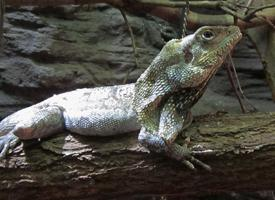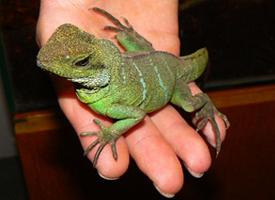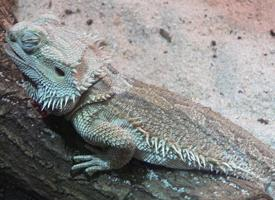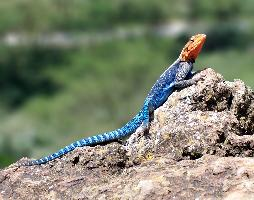
Váhy a míry
| Délka | od 16 do 26 cm |
|---|---|
| Délka ocasu | 44 cm |
Popis zvířete
The Frilled Lizard (Chlamydosaurus kingii), also known as the Frilled Dragon, is a unique and fascinating reptile native to the tropical and warm temperate forests and savanna woodlands of northern Australia and southern New Guinea. This species is most renowned for its remarkable defensive behavior, featuring a large, colorful frill around its neck, which it can display when threatened. The frilled lizard is not just an intriguing creature because of its appearance; it also has captivating behaviors and adaptations that allow it to thrive in its natural habitat.Physical Description
The Frilled Lizard is a relatively large member of the agamid family, with adults reaching lengths of up to 85 to 90 centimeters (about 33 to 35 inches), although a significant portion of this length is accounted for by its elongated tail. The body is slender and agile, adapted for quick movement and climbing. Its coloration varies from brown to gray and can change depending on the lizard's surroundings, a camouflage tactic that helps it blend into the bark of trees and the forest floor.
The most distinctive feature of the Frilled Lizard is, without a doubt, its frill. This frill is made up of long, soft spines of skin that can be erected to form a large, circular display around the lizard's head. The frill is usually folded back against the body and neck but, when extended, it can be as wide as the lizard is long. The frill is brightly colored, with hues of yellow, orange, red, and sometimes even purple, making it a striking visual display. This vivid display is supported by a set of long, flexible cartilage spines, which are connected to the jaw muscles.
Behavior and Diet
The Frilled Lizard is primarily arboreal, spending most of its time in the trees. It is an adept climber, using its sharp claws to grip onto bark and branches. When threatened, it will usually flee by running on its hind legs to find refuge in a tree, its frill flared open as it runs, which serves to intimidate potential predators. This bipedal sprint, combined with the frill's visual display, makes the lizard appear larger and more formidable than it actually is.
Despite its fearsome appearance when threatened, the Frilled Lizard is predominantly an insectivore, feeding on ants, spiders, termites, and small invertebrates. It may also consume small mammals and reptiles when the opportunity arises. Its hunting strategy involves waiting patiently for prey to come close before striking with rapid speed.
Reproduction
The breeding season for Frilled Lizards typically occurs during the early wet season. Males display their frills and engage in aggressive behaviors as a show of dominance to attract females and deter rivals. After mating, the female will lay a clutch of 8 to 23 eggs in a nest dug into the soil. The eggs incubate for two to three months, with the temperature of the nest determining the sex of the offspring, a phenomenon known as temperature-dependent sex determination.
Conservation Status
Currently, the Frilled Lizard is not considered to be at immediate risk of extinction and is classified as "Least Concern" by the International Union for Conservation of Nature (IUCN). However, habitat destruction and the introduction of invasive species pose ongoing threats to their populations. Conservation efforts are focused on habitat preservation and the control of invasive species to ensure that these iconic reptiles continue to thrive in their natural environments.
In conclusion, the Frilled Lizard is a captivating and distinctive reptile, admired not only for its unique appearance and behaviors but also for its adaptability to the diverse ecosystems of northern Australia and southern New Guinea. Its existence adds to the rich biodiversity of the region and highlights the importance of conservation efforts to preserve such unique species and their habitats.
Podobná zvířata
Nové fotografie zvířat
Top 10 zvířat
- Chinese water dragon (Physignathus cocincinus)
- Dolphin gull (Leucophaeus scoresbii)
- Galápagos tortoise (Geochelone nigra complex)
- Japanese macaque (Macaca fuscata)
- Colombian red howler (Alouatta seniculus)
- Sea urchins (Echinoidea)
- Barbary macaque (Macaca sylvanus)
- Diana monkey (Cercopithecus diana)
- Moustached guenon (Cercopithecus cephus)
- Guinea baboon (Papio papio)


